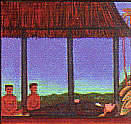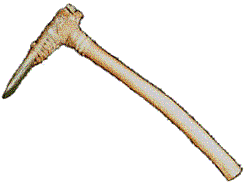First Martyr of Oceania
by M O'Meeghan SM
This year marks the Bi-centenary of the birth of St Peter Chanel; he was born on 12 July 1803, the fifth of eight children in a farming family with a small holding in south-western France. The area was still troubled by the political instability that followed the Revolution. That, plus the need to help on the farm, meant his primary schooling was rather fragmented.
In his early teens the parish priest helped him with special lessons in the presbytery, so that at 16 he was ready to begin his four years of secondary education at the minor seminary. He progressed to the major seminary to be ordained at 24 as a priest for the Belley diocese. For his first year of priesthood he was assistant in a medium sized town, already thinking seriously about applying for an apostolate in the foreign missions. Then followed three years as parish priest in a small country town where the Church was still in disarray a generation after the Revolution. With quiet zeal, tact and compassion he transformed it. Underlying his approach was his personal motto “Aimer Marie et faire l'aimer” - to love Mary and bring others to love her.
In 1831, at 28, with his bishop's agreement he joined the small group of diocesan priests who had hopes of starting a Society of Mary. He was one of the three representatives who went to Rome to ask the Pope's approval for their planned Society of Mary. This approval was given in April 1836 when Marists accepted responsibility for new missions in the little-known south-west Pacific. By the end of that year Peter was one of the first band of missionaries, four priests and three catechist brothers, attached to Bishop Pompallier, who sailed from Le Havre on Christmas Eve for this pioneering mission.
After a prolonged journey out to the Pacific fact-finding and considering possibilities, on All Saints Day 1837 Pompallier placed Fr Peter Bataillon and Br Joseph Luzy on Wallis Island, in an island group north of Fiji. A week later he founded a second mission, leaving Fr Peter Chanel and Br Marie-Nizier Delorme 170km away on Futuna, the smaller island of the two. By then the Bishop had decided to make his base in New Zealand and, via Sydney, landed in Hokianga on 10 January 1838.
For three and a half years on Futuna, Chanel and Marie-Nizier battled with language difficulties, strange customs and food, sickness, malnutrition, loneliness. Hardest to bear was the seeming lack of success in adult conversions. But they persevered, living and preaching the Gospel, in spite of the king's tolerance wearing thin.
The eventual conversion of the king's son proved to be Peter's death warrant. The king kept control of his people largely through their worship of evil spirits. His son's becoming a Christian undermined this power, so Peter had to be stopped. With the king's approval a small group of his tribal leaders clubbed Peter to death while Marie-Nizier was absent visiting elsewhere. It was on 28th April 1841.
When he heard the news of Peter's brutal death, Pompallier sailed to Wallis, accompanied by Fr Philippe Viard, later to be the first bishop of Wellington. Viard went ashore on Futuna, refusing any armed escort, and gathered Peter's remains which were then brought to New Zealand. These were kept reverently at Kororareka (Russell) till 1849 when they were returned to France.
Because of the difficulty of getting reliable eye-witness evidence, it
took the Church a long time to be satisfied that Peter died because of hatred
of the Catholic faith, and not merely through greed for his few possessions,
or resentment at Peter's efforts to act as peacemaker between warring tribes.
He was officially declared a martyr and beatified in 1889.He was declared
a saint by Pope Pius XII in 1954 and, because of his connection with New
Zealand, St Peter Chanel is honoured here with a feast day.

